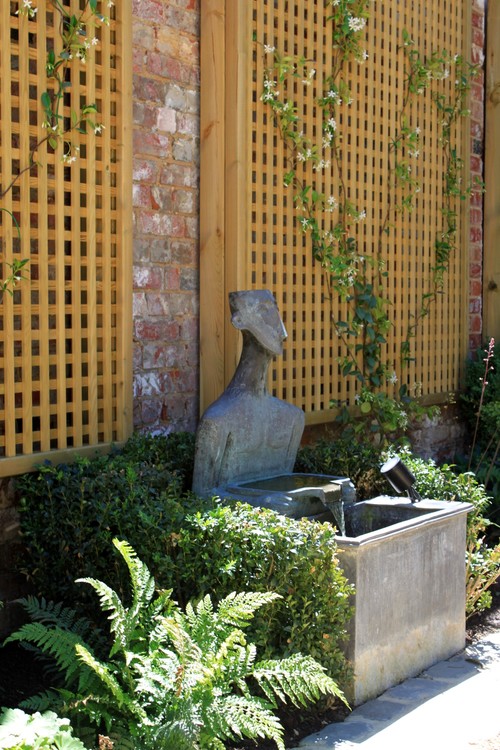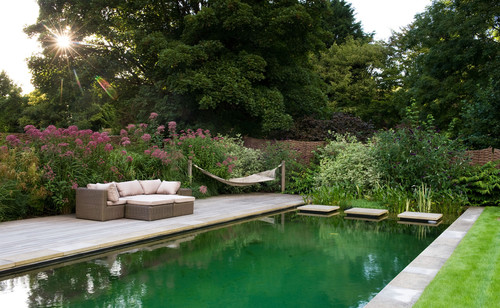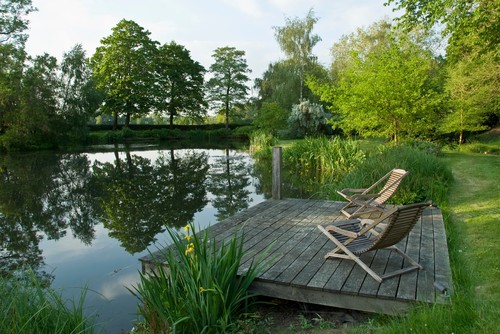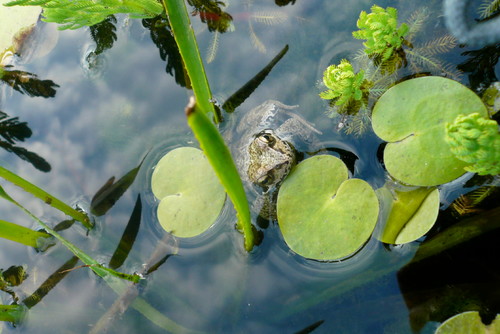8 INSPIRATIONAL IDEAS TO MAKE YOUR BACKYARD COOL
How to have the most awesome yard on the block
For trusted expertise and superior results,
find a landscape professional near you.

Presented by the National Association of Landscape Professionals in partnership with 
By Patricia Tyrrel
There are so many creative ways to add a water feature to a garden, and the design can be modern, traditional or extremely natural. And why just settle for one water feature? If you look at some of the famous gardens that are open to the public, they rarely restrict themselves to one element but instead use water in many different ways.
Start simple. Most of us don’t have space for anything extravagant, such as a pond, so why not begin with a birdbath? A small birdbath can look beautiful and will create a focal point in the garden. Situate it where you can see it from the windows, and watching the birds coming and going will provide endless pleasure.

Pass on digging deep. Not all statement water features need extensive excavation. Here, a simple fountain gives the gentle sound of water and, in addition, an eye-catching sculpture. All you need is an electrical source for the pump, and then the pump can be hidden inside the feature. Or you could make things really simple by opting for one of the solar-powered fountains now available at many garden centers.

Get ready to relax. Water, whether still or flowing, has a tactile quality; you just want to hold your hands under a sheet of water and play with it, or dip your fingers into its surface and create ripples. So why not introduce a water feature beside or near an outdoor sitting area, like here. It adds lots of interest — the reflections, the sound and the feel of it. The evaporation from the pool that the fountain flows into also can help cool the air on a hot summer day.

Dive in. Perhaps you like the idea of being able to swim in your garden but don’t want the harsh-blue, chemically augmented pool that this usually entails. Why not consider a natural pool? This one is rectangular, but you can create more organic shapes by using rocks to landscape.
A natural pool needs to be planted with oxygenating plants at varying depths. Reeds, waterlilies and other water plants will do the job. These plants consume harmful bacteria, decontaminate the water and prevent algal growth. The result? A pond that looks great and is also good for you and the environment.

Downsize your pond. Even a small pool can create a sense of adventure. Adding steppingstones or a bridge instantly invites you to cross or to linger to study the pond’s depths at close quarters.
To create the illusion that the steppingstones are floating on the water, as seen here, treat their supports and also the inner sides of the pool with a black mastic. This will create the perfect reflection as you cannot see into the pool’s inner depths.
Play with sound. Before you even see a water feature in the garden, unless it’s a completely still pool, you will hear it. So it’s worth thinking about how your water feature will sound as well as how it will look. In the famous gardens of Villa d’Este in Italy there are water features that even play music. Probably a little ambitious for your average domestic plot, but more achievable sounds can range from a gentle resonant plink to a gurgling rush, gentle lapping or simple splashes. There is a reason why there are so many words in the English language to describe water sounds. Variation can come from the height and shape of the water — whether it falls as a sheet, flows over rocks or comes out of a spout — and also from the power of the pump that you employ to recirculate it. So next time you see a water feature you like, think about the sound it makes too.

Capture the rain. In nature, rainfall is trapped in various humps and hollows and soaks slowly into the ground, arriving slowly at streams and rivers. When it rains in urban areas, water from all our hard surfaces is usually piped into drains and delivered to rivers. In built-up areas, this process can lead to flooding. Redirecting your rainwater to a low area of the garden, called a rain garden, can enable it to be absorbed slowly back into the soil and into the groundwater. It creates a temporary water feature that can add some fun to the garden after rain.

Capture the landscape. Still water is a mirror, reflecting back the sky and the surrounding trees, plants or buildings, lending a serenity to the scene that little else can compete with. Watching the reflection of clouds or birds or the ripples created by the breeze on the water is very calming and elemental.
The same effect can be achieved whether the pool is formal and small or, like this example, large and informal. The liner or base of the pond needs to be dark so that you will be unable to see the bottom of the pool: This will give the best reflection and a feeling of infinite depth.

Be wild. A garden pond can be a wonderful haven for all kinds of wildlife — frogs, newts, dragonflies, water snails and more. Water also attracts birds to the pond to drink and have a bath, while damp margins provide access for honeybees to drink. This buzz of wildlife will also attract children to investigate, which can play a vital role in stimulating their interest in science and nature. But, of course, safety comes first, so consider this before you decide to introduce one.

Go with the flow. A stream will add a very dynamic element to a garden, as it suggests a source and, in our imagination, gives the impression that it flows on to some distant destination such as a lake or river. It also can introduce a connecting thread through the garden. And by crossing it more than once with bridges or steppingstones, and by introducing clever paths and planting, it can even make your garden appear far bigger and more diverse than it really is. Try a stream that varies in size and in its falls, being wide and peaceful in one area and cascading noisily in another, thus adding different characters to different areas, but with a common thread.
More from Houzz
Natural Pool Desings That Blend With the Landscape
We recently updated our Privacy Policy. By continuing to use this website, you acknowledge that our revised Privacy Policy applies.